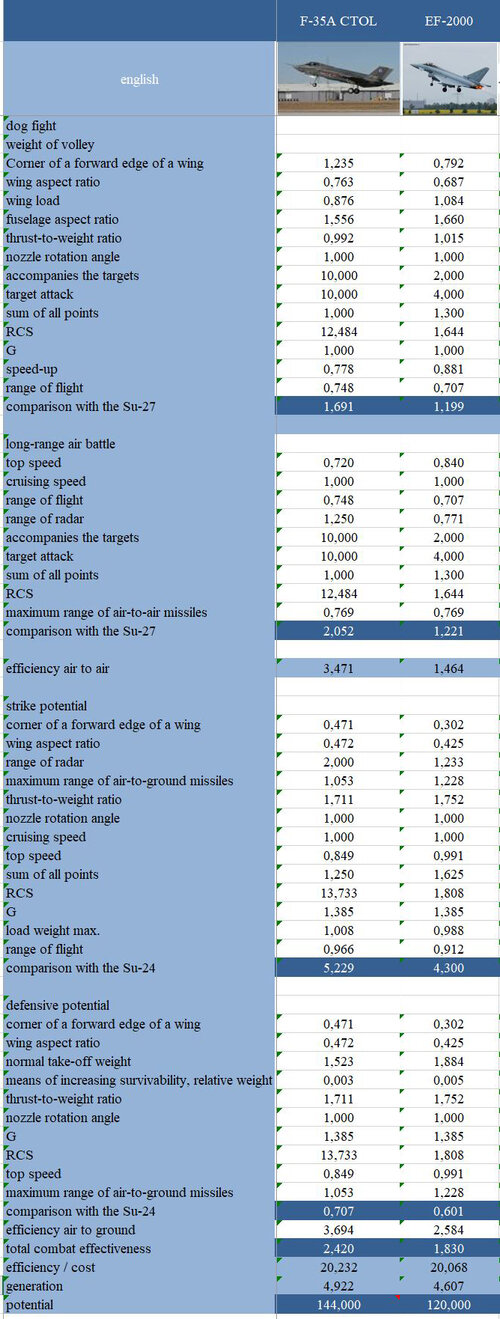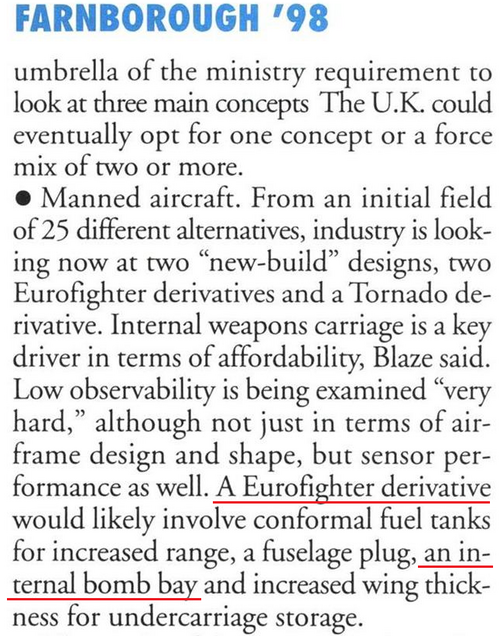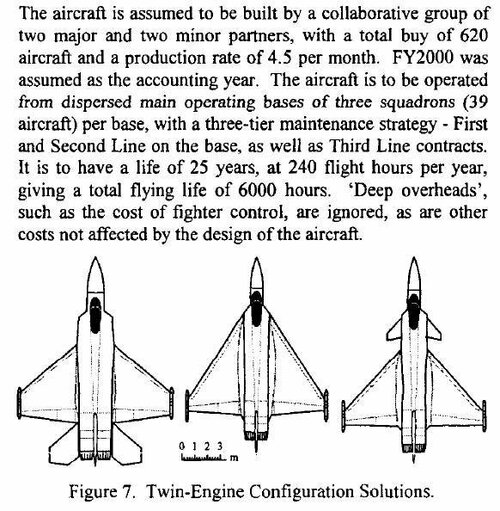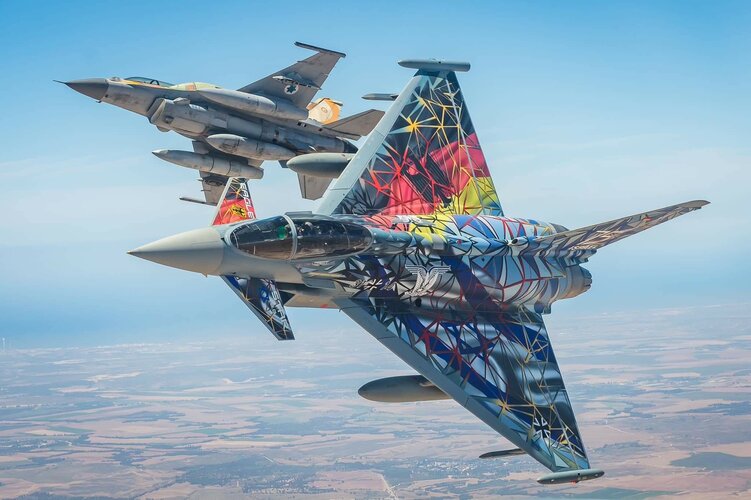F-35 is a compromised bomb truck which main advantage is stealth and data sensor fusion. Manoeuvrability and performance may be much less relevant than in the gun and Sidewinder days, yet fact is Typhoon and Rafale bury the F-35 in that regard.
You are using an out of date browser. It may not display this or other websites correctly.
You should upgrade or use an alternative browser.
You should upgrade or use an alternative browser.
Eurofighter Typhoon
- Thread starter Scorpion82
- Start date
Forest Green
ACCESS: Above Top Secret
- Joined
- 11 June 2019
- Messages
- 5,102
- Reaction score
- 6,696
In terms of raw manoeuvrability yes but 360deg DAS for spotting enemy planes in a dogfight scenario is definitely another major advantage even there.F-35 is a compromised bomb truck which main advantage is stealth and data sensor fusion. Manoeuvrability and performance may be much less relevant than in the gun and Sidewinder days, yet fact is Typhoon and Rafale bury the F-35 in that regard.
Ainen
I really should change my personal text
- Joined
- 25 August 2011
- Messages
- 476
- Reaction score
- 438
Typhoon has substantial superiority in BVR specs - energy state advantage, positioning advantage, break off/evasion advantage.In terms of raw manoeuvrability yes but 360deg DAS for spotting enemy planes in a dogfight scenario is definitely another major advantage even there.F-35 is a compromised bomb truck which main advantage is stealth and data sensor fusion. Manoeuvrability and performance may be much less relevant than in the gun and Sidewinder days, yet fact is Typhoon and Rafale bury the F-35 in that regard.
In WVR - F-35 holds its own quite well both in maneuverability and due to DAS/IRST. Slight irony of the moment - while F-35 club tends to despise WVR, F-35 has a surprising degree of optimization precisely for this mode. Arguably, way more than Typhoon does.
Scorpion82
ACCESS: Confidential
- Joined
- 20 May 2006
- Messages
- 104
- Reaction score
- 100
Typhoon has substantial superiority in BVR specs - energy state advantage, positioning advantage, break off/evasion advantage.In terms of raw manoeuvrability yes but 360deg DAS for spotting enemy planes in a dogfight scenario is definitely another major advantage even there.F-35 is a compromised bomb truck which main advantage is stealth and data sensor fusion. Manoeuvrability and performance may be much less relevant than in the gun and Sidewinder days, yet fact is Typhoon and Rafale bury the F-35 in that regard.
In WVR - F-35 holds its own quite well both in maneuverability and due to DAS/IRST. Slight irony of the moment - while F-35 club tends to despise WVR, F-35 has a surprising degree of optimization precisely for this mode. Arguably, way more than Typhoon does.
The IRST on the F-35 is of limited utility in dogfights due to its position. The EODAS is yet another story and a quite useful capability to have for maintaining situational awareness and performing LOAL shots. I can't see a "surprising degree of optimisation for WVR" though. The F-35 should perform reasonably well, however and is certainly underestimated in WVR combat. How well it actually performs is debatable, but that's true for most aircraft.
Ainen
I really should change my personal text
- Joined
- 25 August 2011
- Messages
- 476
- Reaction score
- 438
Spherical EODAS+helmet combination, maneuverable high AOA setup with excellent nose authority, gun in place. Good acceleration below M=1. Quite compact for its weight.I can't see a "surprising degree of optimisation for WVR" though
Not the worst set to play with? Esp. when compared to its supersonic performance, which is honestly meh (below average for 4th gen).
Forest Green
ACCESS: Above Top Secret
- Joined
- 11 June 2019
- Messages
- 5,102
- Reaction score
- 6,696
It has some nice features that will work well against non-stealth jets, but against the F-35, it will be seen first and hence get fired upon first, in a theoretical match.Typhoon has substantial superiority in BVR specs - energy state advantage, positioning advantage, break off/evasion advantage.
Ainen
I really should change my personal text
- Joined
- 25 August 2011
- Messages
- 476
- Reaction score
- 438
In a theoretical match against each other (or against an opponent of inferior informational capability) - yes, ambush is a king. Otherwise, F-35 qualities really call for something more BWR A2A-focused to cover it, and take from it the missions it is just not good at (everything that involves speed&energy).It has some nice features that will work well against non-stealth jets, but against the F-35, it will be seen first and hence get fired upon first, in a theoretical match.Typhoon has substantial superiority in BVR specs - energy state advantage, positioning advantage, break off/evasion advantage.
A properly upgraded Typhoon (and Spain is talking about new ones), on the other hand, does just that. Being 20 yrs old (just a decade older than the F-35) isn't a big problem here.
kaiserd
I really should change my personal text
- Joined
- 25 October 2013
- Messages
- 1,665
- Reaction score
- 1,616
No one wants the rehash of the F-35 wars seen on this site with topic after topic locked due to the intensity of disagreements.
There are good reasons why the F-35 has in recent years (and continues) to receive far more export orders than the Typhoon.
And a lot of those Typhoons export orders are from countries denied the F-35.
The Eurofighter Typhoon has, in relatively low weight low drag configurations, superior kinetic performance, particularly the higher and faster you go.
In almost all other ways it is at best a rough match for the F-35, in some areas (low observability, survivability against ground threats, data management, etc.) it is significantly inferior.
And it is likely to costs at least as much if not more than for a F-35.
So apart from some very specific but limited number of scenarios the F-35 is probably the better overall selection, as reflected in the respective export order books. Has the Typhoon ever won a direct selection competition versus the F-35? (I’m not recollecting one). Currently, in terms of export orders, the Typhoon doesn’t appear to be able to match the Rafale as runner up to the F-35.
This is not to say the Typhoon is a bad aircraft (it certainly isn’t) or to suggest their are necessarily massive differences in capabilities between these aircraft (or the Rafale and the Gripen E/F, as examples). They each have respective strengths and weaknesses - it’s just some of the weaknesses and strengths have wider importance and impact than others and these appear to be, in general, clearly favouring the F-35.
And split buys by existing Typhoon operators (including new Typhoon top-up buys) do make some sense from industrial and balancing capabilities perspectives.
There are good reasons why the F-35 has in recent years (and continues) to receive far more export orders than the Typhoon.
And a lot of those Typhoons export orders are from countries denied the F-35.
The Eurofighter Typhoon has, in relatively low weight low drag configurations, superior kinetic performance, particularly the higher and faster you go.
In almost all other ways it is at best a rough match for the F-35, in some areas (low observability, survivability against ground threats, data management, etc.) it is significantly inferior.
And it is likely to costs at least as much if not more than for a F-35.
So apart from some very specific but limited number of scenarios the F-35 is probably the better overall selection, as reflected in the respective export order books. Has the Typhoon ever won a direct selection competition versus the F-35? (I’m not recollecting one). Currently, in terms of export orders, the Typhoon doesn’t appear to be able to match the Rafale as runner up to the F-35.
This is not to say the Typhoon is a bad aircraft (it certainly isn’t) or to suggest their are necessarily massive differences in capabilities between these aircraft (or the Rafale and the Gripen E/F, as examples). They each have respective strengths and weaknesses - it’s just some of the weaknesses and strengths have wider importance and impact than others and these appear to be, in general, clearly favouring the F-35.
And split buys by existing Typhoon operators (including new Typhoon top-up buys) do make some sense from industrial and balancing capabilities perspectives.
This is true.Spherical EODAS+helmet combination, maneuverable high AOA setup with excellent nose authority, gun in place. Good acceleration below M=1. Quite compact for its weight.I can't see a "surprising degree of optimisation for WVR" though
Not the worst set to play with? Esp. when compared to its supersonic performance, which is honestly meh (below average for 4th gen).
With 50deg official AoA, with (probably) moderate yaw available for most of this range, that's huge...
That's exactly 10 to 5 deg above Tomcat (yes, the legendary king of Alpha until Hornet came).
It's exactly what the best of a SH can achieve (but with restricted yaw)
At best 60 to70%(!) percent more than what Dassault can claim for the Rafale (when their salesmen get ecstatic).
Nearly twice what a non wedged Typhoon can claim
Twice (nearly) that of a classic Flanker (outside of post stall)
50% more than the Eagle, the king of WVR!!!
C'mon guys, Lightning rules there.
Last edited:
Says who? Not the pilots.F-35 is a compromised bomb truck
paralay
ACCESS: Top Secret
Scorpion82
ACCESS: Confidential
- Joined
- 20 May 2006
- Messages
- 104
- Reaction score
- 100
Could we now get back to topic, it's drifting into bad directions...
Here is an example of how this charade of job claims is counter-productive:
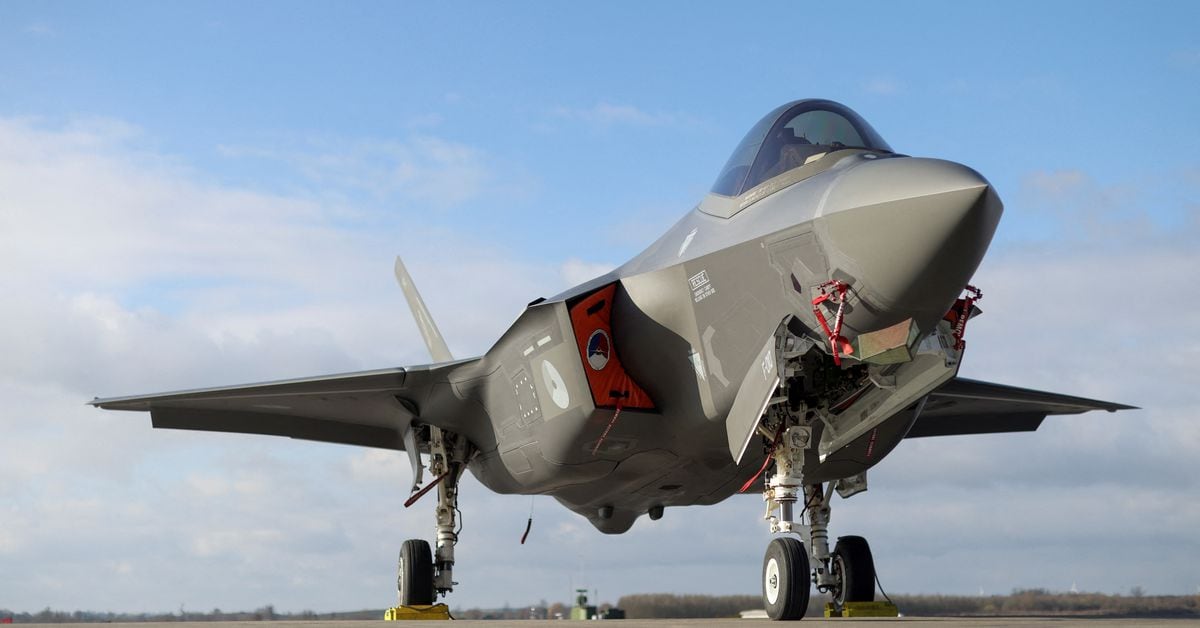
 www.reuters.com
www.reuters.com

UK says Lockheed Martin, BAE Systems win nearly $200 mln contract, to create 140 jobs
Lockheed Martin Corp and BAE Systems Plc won a F-35 jet maintenance support contract worth 161 million pounds ($200 million), creating 140 jobs in Britain, the country's Ministry of Defence said on Tuesday.
Scorpion82
ACCESS: Confidential
- Joined
- 20 May 2006
- Messages
- 104
- Reaction score
- 100
Here is an example of how this charade of job claims is counter-productive:

UK says Lockheed Martin, BAE Systems win nearly $200 mln contract, to create 140 jobs
Lockheed Martin Corp and BAE Systems Plc won a F-35 jet maintenance support contract worth 161 million pounds ($200 million), creating 140 jobs in Britain, the country's Ministry of Defence said on Tuesday.www.reuters.com
There is certainly a difference in the number of jobs for a foreign project with limited work for the national industry, compared to a home grown project, where the MoD and AF have more insight and a much greater lever to influence the direction such a programme is heading. This naturally entails higher costs as well. So it's a choice between political souvereighnity, economical and industrial benefits and military requirements and capabilities. There are certainly conflicting interests and all solutions enforce compromises.
red admiral
ACCESS: Top Secret
- Joined
- 16 September 2006
- Messages
- 1,468
- Reaction score
- 1,541
I think they are still recent enough to not be declassified and into the archives. "Thick wing" is better description than "big wing" but there were a bunch of variations around Typhoon and Tornado done for FOA/FOAS under P151, P148. BAe drew a lot of concepts.Several years ago there was some talk about a "big wing" Typhoon. I have never found a more detailed description or even a sketch. Does anyone have more information about it?
FighterJock
ACCESS: Top Secret
- Joined
- 29 October 2007
- Messages
- 4,222
- Reaction score
- 3,413
I do wonder wonder if the technology from all the FOAS/big wing Typhoon would ever be found on the GCAP.
Manuducati
ACCESS: Secret
- Joined
- 25 November 2020
- Messages
- 228
- Reaction score
- 640
Might be related to this?
From https://www.key.aero/forum/modern-m...r-typhoon-derivatives-briefly-studied-in-1999
From https://www.key.aero/forum/modern-m...r-typhoon-derivatives-briefly-studied-in-1999
Attachments
With 50deg official AoA, with (probably) moderate yaw available for most of this range, that's huge...
1) High-AoA capability is but one measure of maneuverability.
2) It's certainly not the only one deciding the outcome of a fight.
3) AoA limit =/= stall AoA.
4) On some of the aircraft you mention, the AoA limit is a soft one (Su-27).
Case in point: the Flanker is impressive not so much because of it's high-AoA capability (as you say, at least the Hornet has it beat in that regard) but due to the fact that this does not come (as it does in the F/A-18...) at the expense of other areas of performance. It'll out-accelerate, out-climb and (at speed and altitude) out-turn the Hornet, giving the F-15 and F-16 a run for their money in these respects. It's not the best in every regard but, save for relatively sluggish roll-response due to the wide engine separation not doing it any favours, the Su-27 just doesn't have any glaring weaknesses for a contemporary opponent to exploit. A competent F-16 pilot can force a less experienced Hornet driver into a situation where he has a clear performance advantage, and vice versa. That's a lot harder to achieve against a Flanker.
F-2
ACCESS: Top Secret
- Joined
- 22 May 2020
- Messages
- 694
- Reaction score
- 1,211
Subsonic the Super Hornet out accelerates a Su-27 and is close to the Su-35With 50deg official AoA, with (probably) moderate yaw available for most of this range, that's huge...
1) High-AoA capability is but one measure of maneuverability.
2) It's certainly not the only one deciding the outcome of a fight.
3) AoA limit =/= stall AoA.
4) On some of the aircraft you mention, the AoA limit is a soft one (Su-27).
Case in point: the Flanker is impressive not so much because of it's high-AoA capability (as you say, at least the Hornet has it beat in that regard) but due to the fact that this does not come (as it does in the F/A-18...) at the expense of other areas of performance. It'll out-accelerate, out-climb and (at speed and altitude) out-turn the Hornet, giving the F-15 and F-16 a run for their money in these respects. It's not the best in every regard but, save for relatively sluggish roll-response due to the wide engine separation not doing it any favours, the Su-27 just doesn't have any glaring weaknesses for a contemporary opponent to exploit. A competent F-16 pilot can force a less experienced Hornet driver into a situation where he has a clear performance advantage, and vice versa. That's a lot harder to achieve against a Flanker.
F-16.net View topic - F-35 vs. Mig-29
Military aviation forum since 2003, with high quality discussion focusing on the F-16, F-35 and F-22 jet fighters and the C-130.
www.f-16.net
I’m not posting the super hornet manual but it can be found online. The Su-27 figures come from this report.Fun fact:
In terms of subsonic acceleration, Super hornet can easily out-accelerate Su-27/30, and is very close to Su-35.
Su-27, Low altitude, 18920 kg flying wight, accelerate from 600km/h to 1100km/h in 15 seconds. Average acceleration is 9.26m/s^2.
Superhornet, 17241 kg flying weight (definitely more ordnance than a 18920 kg Su-27), accelerate:
from 360knots to 420 knots, in 3 seconds, average 10.28m/m^s
from 420knots to 480 knots, in 4 seconds, average 7.71m/m^s
from 480knots to 520 knots, in 2 seconds, average 10.28m/m^s
from 520knots to 550 knots, in 1 second, average 15.43m/m^s
(From super hornet block 2 flight manual, performance data, Edition Sep. 2008)
The super hornet for all its faults has impressive subsonic acceleration. The 402 powered legacy hornet is supposedly on par with an Eagle. MIG-29 and F-16 are in a class of their own, F-35 is supposedly on par with a block 50 F-16 subsonic.
The Typhoon is probably the best of the lot though I do wonder if it’s subsonic acceleration matches the Viper I have no doubt it’s supersonic is superior.
Attachments
That is an apples to oranges comparison in several ways: AFAIK the Russian data is TAS vs. EAS for the Super Hornet, and those times quoted are for sea level, while the Su-27 figures apply to 1000m. As the drag index is 0 for the SH, the aircraft is by definition unarmed...
If you want to roughly equalize the data, take the numbers for 4000ft @38klb/DI=0 and add 100/117*4s to the time, which gives you 15.4s. This accounts for the fact that 360 to 550KIAS works out to 700 to 1070km/h TAS at 1000m and 420KIAS is 817km/h TAS. Most of the "missing" speed difference is at the lower end, so we take the time to gain the 117km/h from 360 to 420KIAS (4 seconds) and calculate how long it takes to add 100km/h at that acceleration. We'll gloss over the 30km/h at the top end (nominally worth another second) to maybe compensate for the fact that we've been using data for 4000ft rather than 3300ft.
Admittedly, this is still better than I would have given the SH credit for, but makes slower than the (15 years older) Su-27.
If you want to roughly equalize the data, take the numbers for 4000ft @38klb/DI=0 and add 100/117*4s to the time, which gives you 15.4s. This accounts for the fact that 360 to 550KIAS works out to 700 to 1070km/h TAS at 1000m and 420KIAS is 817km/h TAS. Most of the "missing" speed difference is at the lower end, so we take the time to gain the 117km/h from 360 to 420KIAS (4 seconds) and calculate how long it takes to add 100km/h at that acceleration. We'll gloss over the 30km/h at the top end (nominally worth another second) to maybe compensate for the fact that we've been using data for 4000ft rather than 3300ft.
Admittedly, this is still better than I would have given the SH credit for, but makes slower than the (15 years older) Su-27.
Forest Green
ACCESS: Above Top Secret
- Joined
- 11 June 2019
- Messages
- 5,102
- Reaction score
- 6,696
There was a quote from some test pilot who'd flown both that the Typhoon's maximum climb rate was 25% better than the F-16's.I’m not posting the super hornet manual but it can be found online. The Su-27 figures come from this report.
The super hornet for all its faults has impressive subsonic acceleration. The 402 powered legacy hornet is supposedly on par with an Eagle. MIG-29 and F-16 are in a class of their own, F-35 is supposedly on par with a block 50 F-16 subsonic.
The Typhoon is probably the best of the lot though I do wonder if it’s subsonic acceleration matches the Viper I have no doubt it’s supersonic is superior.
Last edited:
F-2
ACCESS: Top Secret
- Joined
- 22 May 2020
- Messages
- 694
- Reaction score
- 1,211
Yea, but if I recall correctly he was Scandinavian and this was an F-16a or MLU. The GE Vipers and the 229 ones have much better subsonic acceleration. Comparing the F-16 block 15 SAC and the HAF block 50 manual it can easily beat an F-16a’s acceleration by at least that amount. I don’t doubt the Typhoon will crush it above mach 1, and maybe this guy was talking about C models IDK, Just the EJ200 design specs makes me wonder.There was a quote from some test pilot who'd flown both that the Typhoon's maximum climb rate was 25% better than the F-16's.I’m not posting the super hornet manual but it can be found online. The Su-27 figures come from this report.
The super hornet for all its faults has impressive subsonic acceleration. The 402 powered legacy hornet is supposedly on par with an Eagle. MIG-29 and F-16 are in a class of their own, F-35 is supposedly on par with a block 50 F-16 subsonic.
The Typhoon is probably the best of the lot though I do wonder if it’s subsonic acceleration matches the Viper I have no doubt it’s supersonic is superior.
Forest Green
ACCESS: Above Top Secret
- Joined
- 11 June 2019
- Messages
- 5,102
- Reaction score
- 6,696
It was a C IIRC, not sure which block. The Typhoon does have a substantial TWR advantage.
- Joined
- 24 November 2008
- Messages
- 1,334
- Reaction score
- 1,682
Attachments
ITP from Spain had a thrust vector system for the EJ200 on their stand at FEINDEF 23....I didn't know where else to post this.
More EF's for Spain
More EF's for Spain
Last edited:
FighterJock
ACCESS: Top Secret
- Joined
- 29 October 2007
- Messages
- 4,222
- Reaction score
- 3,413
At long last, looks like the Typhoon will finally be getting thrust vectoring capability.
snne
ACCESS: Top Secret
- Joined
- 3 July 2022
- Messages
- 576
- Reaction score
- 1,546
Could it be for a demonstrator instead? Like the Chinese J-10C TVC?At long last, looks like the Typhoon will finally be getting thrust vectoring capability.
FighterJock
ACCESS: Top Secret
- Joined
- 29 October 2007
- Messages
- 4,222
- Reaction score
- 3,413
Somehow I don't think so snne, I would think that thrust vectoring would enter service operationally on the Typhoon.
timmymagic
Forever disappointed in MoD procurement...
- Joined
- 23 August 2011
- Messages
- 1,055
- Reaction score
- 2,801
I'm afraid thats the same unit from years ago...they've just dug it out again. Fills the display stand up though...At long last, looks like the Typhoon will finally be getting thrust vectoring capability.
Similar story with AMK...
Last edited:
timmymagic
Forever disappointed in MoD procurement...
- Joined
- 23 August 2011
- Messages
- 1,055
- Reaction score
- 2,801
It already is a 'strike' Eurofighter...Storm Shadow, Brimstone, Paveway II & IV, JDAM, Litening pods, KEPD350, Marte ER and Spear (on the way)...with thousands of actual combat missions under its belt...If they are serious about the Typhoon becoming a SEAD platform or some kind of strike Eurofighter they really do need on or the other.
And yet neither thrust vectoring or AMK have been required yet..
kaiserd
I really should change my personal text
- Joined
- 25 October 2013
- Messages
- 1,665
- Reaction score
- 1,616
That appears to be a rather nonsensical comment. Please explain your reasoning re: the Eurofighter.Thrust vectoring or AMK will be needed for large asymmetric loads. If they are serious about the Typhoon becoming a SEAD platform or some kind of strike Eurofighter they really do need on or the other.
F-2
ACCESS: Top Secret
- Joined
- 22 May 2020
- Messages
- 694
- Reaction score
- 1,211
Paper on AMK kit how asymmetric vortexes limited AoA and correcting it will allow it to meet new range and payload requirements.
FCAS Might Disrupt MultinationalEurofighter Fleet Plans
AWST 10/25/21(Relevant section only)
BAE is also envisaging that partner nations will adopt the Aerodynamic Modification Kit (AMK), first developed by Airbus in Germany in 2015 to provide improved maneuverability and longitudinal stability for the canardequipped aircraft.
According to Mallery-Blythe, introduction of the AMK can make it quicker and easier to integrate new weapons, a costly and time-consuming process on theplatform, and could also pave the way for carriage of asymmetric stores.
Iirc, upgrade to the EJ200 is indeed part of what is being researched under LTE program, though afaik those improvements are focused around thrust and fuel economy rather than vectored thrust. I'm doubtful to say the least if any of the major Eurofighter operators are interested in TVC in the first place.
F-2
ACCESS: Top Secret
- Joined
- 22 May 2020
- Messages
- 694
- Reaction score
- 1,211
I’d be very interested in an increased thrust typhoon.Iirc, upgrade to the EJ200 is indeed part of what is being researched under LTE program, though afaik those improvements are focused around thrust and fuel economy rather than vectored thrust. I'm doubtful to say the least if any of the major Eurofighter operators are interested in TVC in the first place.
timmymagic
Forever disappointed in MoD procurement...
- Joined
- 23 August 2011
- Messages
- 1,055
- Reaction score
- 2,801
Allegedly the TVC developed was assessed as helping fuel economy.I'm doubtful to say the least if any of the major Eurofighter operators are interested in TVC in the first place.
But what you'd save in fuel costs you'd pay ten times that in a new test programme across the entire flight envelope...
Uprated engines, TVC and AMK would make the Typhoon easily the most manoeuverable and fastest fighter out there...but it is never going to happen...
donnage99
"Robert Gates, is that you??" sublight
- Joined
- 16 June 2008
- Messages
- 1,215
- Reaction score
- 407
Trimming drag in certain flight regime while adding weight which adds drags accross the board. I think the trimming drag part is mainly for increased kinetic performance in transonic flight not so much about fuel saving.Allegedly the TVC developed was assessed as helping fuel economy.
But what you'd save in fuel costs you'd pay ten times that in a new test programme across the entire flight envelope...
timmymagic
Forever disappointed in MoD procurement...
- Joined
- 23 August 2011
- Messages
- 1,055
- Reaction score
- 2,801
It was one of the marketing points for it, IIRC they were claiming 'up to' 7% fuel saving...I think the trimming drag part is mainly for increased kinetic performance in transonic flight not so much about fuel saving.
Similar threads
-
-
-
Air to Ground Combat Tactics: Use of PGM on night and poor visibility
- Started by Pit
- Replies: 3
-
-
Questions about Typhoon CAPTOR radar
- Started by ROCAF2003
- Replies: 0

